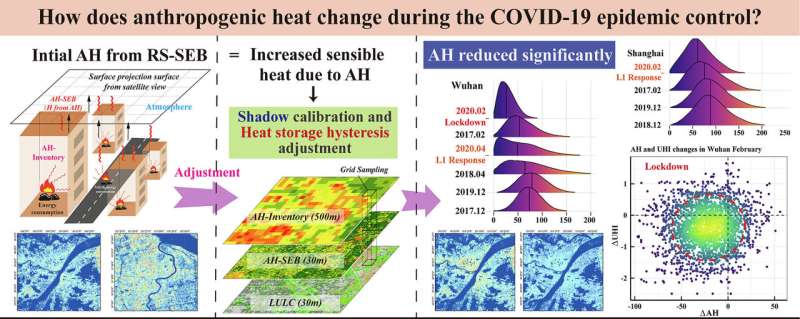This article has been reviewed according to Science X's editorial process and policies. Editors have highlighted the following attributes while ensuring the content's credibility:
fact-checked
trusted source
proofread
Scientists propose novel method to estimate human-caused heat emission

Why are cities usually warmer than rural areas? Scientist have long known that cities retain heat more than rural areas, a phenomenon known as urban heat island (UHI), which is largely due to the impact of anthropogenic heating, or human-caused heating.
A research team led by Prof. Meng Qingyan from the Aerospace Information Research Institute (AIR) of the Chinese Academy of Sciences (CAS) has proposed an estimation method to quantify the impacts of anthropogenic heat (AH) on UHI.
The study was published in Remote Sensing of Environment.
The researchers investigated four Chinese megacities including Wuhan, Shanghai, Beijing, and Guangzhou during COVID-19 restriction period, when human activities and AH were reduced in these cities.
To clarify the effects of COVID-19 control measures on AH, they focused on quantitative assessments by proposing a new AH estimation method based on a remote sensing surface energy balance without hysteresis from heat storage.
They found that the reduction was up to 50% in Wuhan during the lockdown in February 2020 and gradually decreased after the lockdown was eased in April 2020, similar to that in Shanghai during the Level 1 pandemic response. In contrast, AH was less reduced in Guangzhou during the same period and increased in Beijing owing to extended central heating use in winter.
The researchers also found that AH decreased more in urban centers and the change in AH varied in terms of urban land use between cities and periods.
"With a much higher spatial resolution, the resulting AH was consistent with the latest global AH dataset, providing 'objective and refined features of human activities during the pandemic'," said Prof. Meng.
Although UHI changes during the COVID-19 pandemic cannot be entirely attributed to AH changes, the considerable reduction in AH is an important feature accompanying the weakening of the UHI.
More information: Qingyan Meng et al, Anthropogenic heat variation during the COVID-19 pandemic control measures in four Chinese megacities, Remote Sensing of Environment (2023). DOI: 10.1016/j.rse.2023.113602
Provided by Chinese Academy of Sciences




















